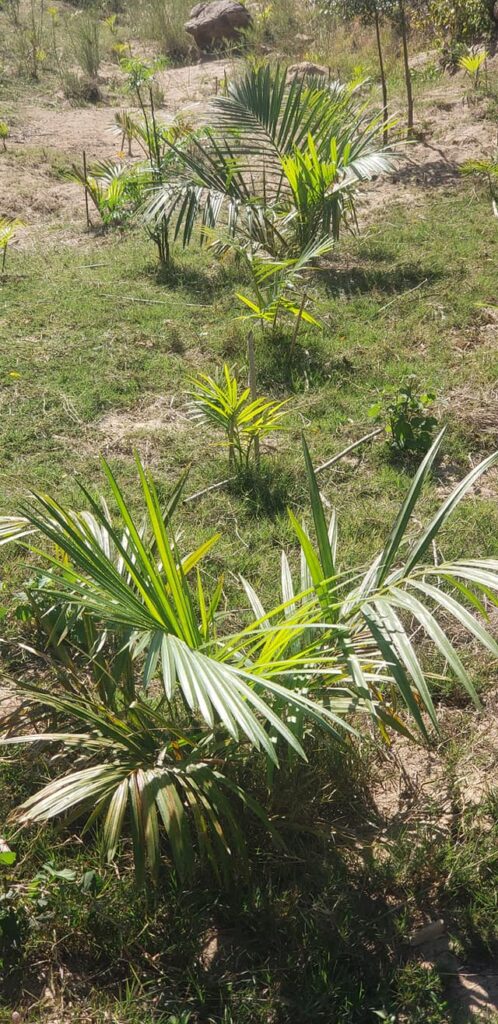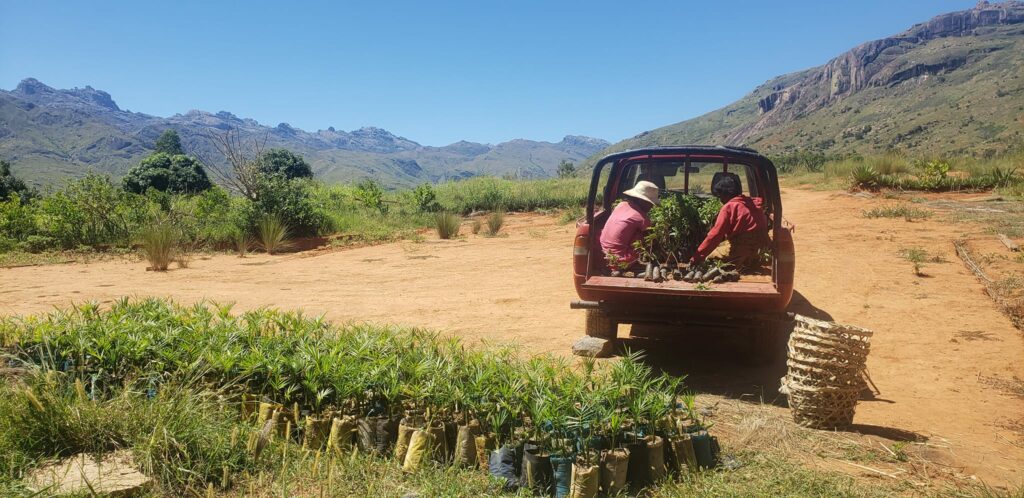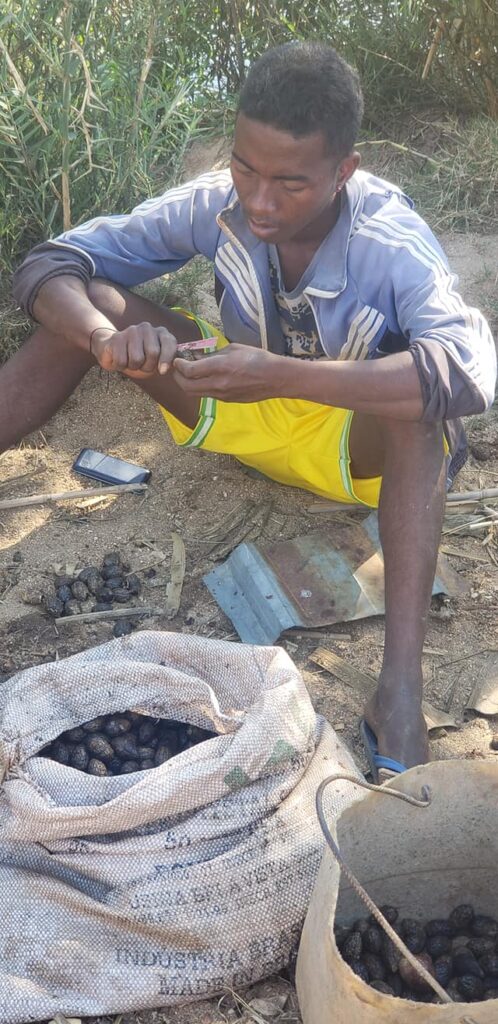
Raffia palm is cultivated in wet or swampy areas due to its well-adapted nature to such environments. There are several reasons why raffia is commonly planted in wet areas:
Water Accessibility: Raffia palms have a high water requirement, and wet areas provide a consistent and abundant water supply. The proximity to water sources, such as rice fields, swamps or wetlands, ensures that the raffia palms have access to the moisture they need to thrive.
Soil Conditions: Wet areas often have specific soil conditions that are well-suited for raffia cultivation. The soil in these regions is usually rich in organic matter, providing essential nutrients for the growth of the palm. Additionally, the consistent moisture in the soil promotes healthy root development.
Prevention of Drought Stress: Raffia palms are sensitive to drought stress, and planting them in wet areas helps prevent moisture deficiencies. The constant availability of water in these environments minimizes the risk of water-related stress and promotes consistent and vigorous growth.
Erosion Control: Raffia palms play a crucial role in soil conservation and erosion control. Planted along riverbanks or in wet areas, the extensive root systems of raffia palms help bind the soil, preventing erosion and promoting stability in areas prone to water movement.
Biodiversity and Ecosystem Benefits: Wet areas are often ecologically rich and support diverse ecosystems. Planting raffia palms in these areas contributes to biodiversity by providing habitats for various plant and animal species. Raffia cultivation can be part of sustainable agroforestry practices that benefit both the environment and local communities.
Economic Significance: Raffia palms are economically important for the production of materials such as raffia fiber, which is used in various industries. Planting raffia in wet areas ensures a sustainable supply of this valuable resource, supporting local economies and traditional crafts.
Overall, planting raffia in wet areas aligns with the plant’s natural habitat requirements and offers a range of ecological, economic, and practical advantages that contribute to the sustainability of both the plant and the surrounding environment.




 Raffia palm is cultivated in wet or swampy areas due to its well-adapted nature to such environments. There are several reasons why raffia is commonly planted in wet areas:
Water Accessibility: Raffia palms have a high water requirement, and wet areas provide a consistent and abundant water supply. The proximity to water sources, such as rice fields, swamps or wetlands, ensures that the raffia palms have access to the moisture they need to thrive.
Soil Conditions: Wet areas often have specific soil conditions that are well-suited for raffia cultivation. The soil in these regions is usually rich in organic matter, providing essential nutrients for the growth of the palm. Additionally, the consistent moisture in the soil promotes healthy root development.
Prevention of Drought Stress: Raffia palms are sensitive to drought stress, and planting them in wet areas helps prevent moisture deficiencies. The constant availability of water in these environments minimizes the risk of water-related stress and promotes consistent and vigorous growth.
Erosion Control: Raffia palms play a crucial role in soil conservation and erosion control. Planted along riverbanks or in wet areas, the extensive root systems of raffia palms help bind the soil, preventing erosion and promoting stability in areas prone to water movement.
Biodiversity and Ecosystem Benefits: Wet areas are often ecologically rich and support diverse ecosystems. Planting raffia palms in these areas contributes to biodiversity by providing habitats for various plant and animal species. Raffia cultivation can be part of sustainable agroforestry practices that benefit both the environment and local communities.
Economic Significance: Raffia palms are economically important for the production of materials such as raffia fiber, which is used in various industries. Planting raffia in wet areas ensures a sustainable supply of this valuable resource, supporting local economies and traditional crafts.
Overall, planting raffia in wet areas aligns with the plant’s natural habitat requirements and offers a range of ecological, economic, and practical advantages that contribute to the sustainability of both the plant and the surrounding environment.
Raffia palm is cultivated in wet or swampy areas due to its well-adapted nature to such environments. There are several reasons why raffia is commonly planted in wet areas:
Water Accessibility: Raffia palms have a high water requirement, and wet areas provide a consistent and abundant water supply. The proximity to water sources, such as rice fields, swamps or wetlands, ensures that the raffia palms have access to the moisture they need to thrive.
Soil Conditions: Wet areas often have specific soil conditions that are well-suited for raffia cultivation. The soil in these regions is usually rich in organic matter, providing essential nutrients for the growth of the palm. Additionally, the consistent moisture in the soil promotes healthy root development.
Prevention of Drought Stress: Raffia palms are sensitive to drought stress, and planting them in wet areas helps prevent moisture deficiencies. The constant availability of water in these environments minimizes the risk of water-related stress and promotes consistent and vigorous growth.
Erosion Control: Raffia palms play a crucial role in soil conservation and erosion control. Planted along riverbanks or in wet areas, the extensive root systems of raffia palms help bind the soil, preventing erosion and promoting stability in areas prone to water movement.
Biodiversity and Ecosystem Benefits: Wet areas are often ecologically rich and support diverse ecosystems. Planting raffia palms in these areas contributes to biodiversity by providing habitats for various plant and animal species. Raffia cultivation can be part of sustainable agroforestry practices that benefit both the environment and local communities.
Economic Significance: Raffia palms are economically important for the production of materials such as raffia fiber, which is used in various industries. Planting raffia in wet areas ensures a sustainable supply of this valuable resource, supporting local economies and traditional crafts.
Overall, planting raffia in wet areas aligns with the plant’s natural habitat requirements and offers a range of ecological, economic, and practical advantages that contribute to the sustainability of both the plant and the surrounding environment.
 Preparing raffia seeds is a meticulous process that involves several steps to extract and refine the valuable material from the raffia palm.
The process begins with the harvesting of mature raffia palm fruits, which are known for their distinctive elongated shape and fibrous outer layer.
The first step in preparing raffia seeds is the careful extraction of the seeds from the fibrous husk.
This often requires skilled hands to navigate through the tough outer layer without damaging the seeds inside.
Once extracted, the seeds undergo a cleaning process to remove any remaining husk particles and impurities.
This is typically done through manual sorting or with the help of simple tools.
After cleaning, the raffia seeds are typically sun-dried to ensure they are free from excess moisture.
This step is crucial to prevent the growth of mold and maintain the quality of the seeds.
The drying process can take several days and requires a controlled environment to protect the seeds from adverse weather conditions.
Following the drying phase,
Preparing raffia seeds is a meticulous process that involves several steps to extract and refine the valuable material from the raffia palm.
The process begins with the harvesting of mature raffia palm fruits, which are known for their distinctive elongated shape and fibrous outer layer.
The first step in preparing raffia seeds is the careful extraction of the seeds from the fibrous husk.
This often requires skilled hands to navigate through the tough outer layer without damaging the seeds inside.
Once extracted, the seeds undergo a cleaning process to remove any remaining husk particles and impurities.
This is typically done through manual sorting or with the help of simple tools.
After cleaning, the raffia seeds are typically sun-dried to ensure they are free from excess moisture.
This step is crucial to prevent the growth of mold and maintain the quality of the seeds.
The drying process can take several days and requires a controlled environment to protect the seeds from adverse weather conditions.
Following the drying phase,